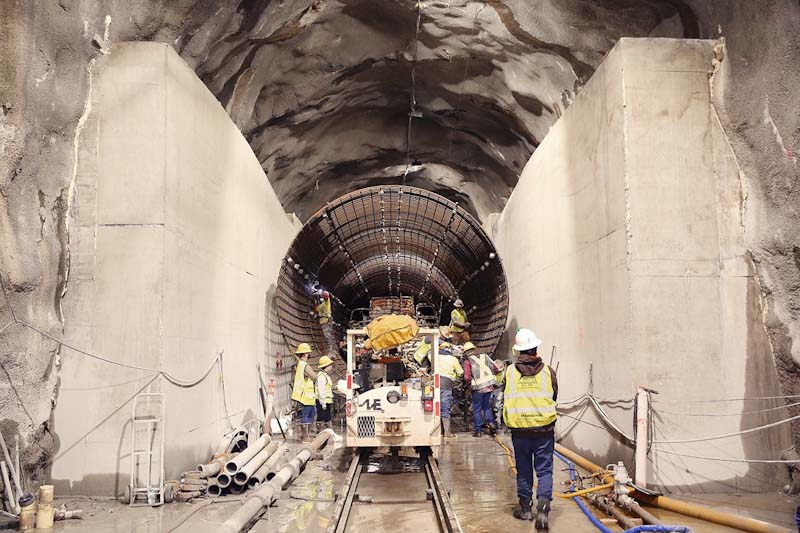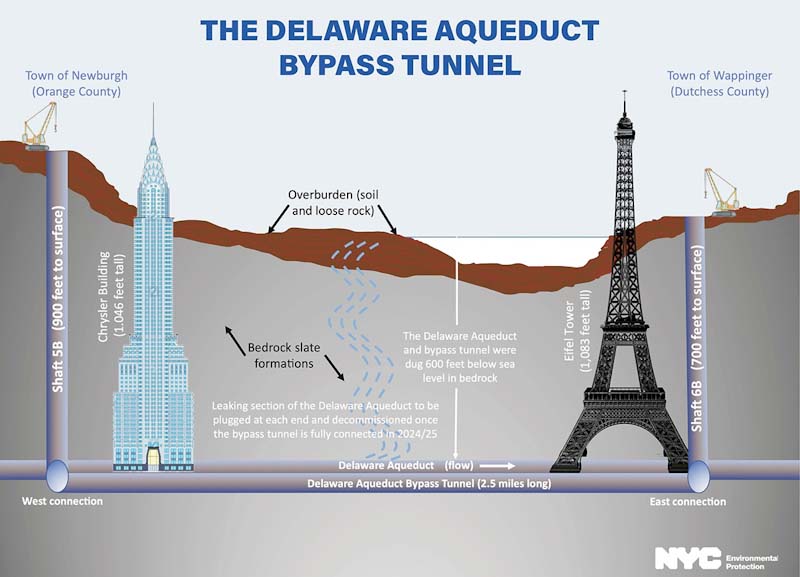NYCDEP Begins Final Phase of $2 Billion Delaware Aqueduct Bypass Tunnel Repairs
NEW YORK – New York City loses millions of gallons of water each day from leaks in the Delaware Aqueduct Tunnel upstate, the equivalent of flooding all 32 NFL football fields this Sunday with three feet of water. Then again on Monday, on Tuesday and on and on.
To stop this massive water loss, the New York City Department of Environmental Protection recently launched the final phase of DEP’s largest-ever infrastructure repair project—the $2-billion Delaware Aqueduct Repair Project. Two decades in its planning, the project will ensure that the Delaware Aqueduct—the world’s longest tunnel of any kind—continues to bring New Yorkers the highest quality drinking water in the nation for generations to come.
Over the past 11 years, the city has been constructing a 2.5-mile bypass tunnel around a large leak near Newburgh, NY in Orange County, and is preparing to fix another leak in Ulster County. In this final phase, the city will connect the ends of that tunnel to the main aqueduct, seal off the leaking portion near Newburgh, and repair the leak under Ulster County.

“New York City’s tap water is the envy of the world—it’s why we have the best pizza and bagels in the country,” said Mayor Eric Adams at a press conference on Sept. 30. “Today, we’re kicking off the final phase of a 11-year project to secure the future of our water supply and make sure that New Yorkers can continue to enjoy the billion gallons of drinking water we use every day. In order to fix the 35-million gallon per day leaks in the Delaware Aqueduct, we’ve built a 2.5-mile bypass tunnel, and over the course of the next several months, we’re going to connect that bypass tunnel to the main aqueduct as part of the largest repair project in DEP’s history.”
A temporary unintended consequence could be water tasting and smelling slightly different for a few months, he said, noting that it will still be “perfectly safe to drink.”
NYC DEP Commission Rohit Aggarwala noted that nearly 10 million New Yorkers count on his department for high-quality water on a daily basis. “We will continue to do that during this complex repair and will ensure we meet that essential mission for generations to come,” he said.
With an eye on the commercial water market, he observed, “Just like different brands of bottled water taste a bit different, so do our different reservoirs. While some residents may notice a temporary, subtle difference in taste or aroma during the repairs as we change our famous blend, our water remains clean and safe to drink.”
The New York City Department of Environmental Protection announced on June 28, 2023 a schedule change for planned work on the Delaware Aqueduct, the world’s longest tunnel, with the major work completing the project delayed one year. The project is now scheduled to begin this month.
The project, which calls for shutting down a portion of the aqueduct in order to attach a bypass tunnel under the Hudson River, was scheduled to last up to eight months. The shift in schedule allows for additional pumps, as well as related drainage infrastructure and electrical support, to be installed to keep the construction zone dry and ensure worker safety during this complex repair of decades-old leaks.
Throughout the repairs, DEP said it will “rely upon the redundancy of its robust 19-reservoir system to continue to deliver clean, safe water at the levels its customers currently depend upon. Specifically, there will be increased amounts of drinking water coming from the Croton Watershed, a group of 12 reservoirs and three controlled lakes in Westchester and Putnam counties, to feed New York City’s water supply.” The DEP also stated that thanks to the many redundant sources of water, and its interconnected set of aqueducts and water tunnels, “there will be no impact on the amount of water being supplied to the city. As DEP does every day, the agency’s scientists and technicians will continuously monitor the water supply.”
DEP also completed significant capital projects to prepare for this phase, including increasing the Catskill Aqueduct’s capacity, upgrading reservoirs across the watershed, and more.
Decades of extensive planning, robust system capacity and redundancies, and careful management and oversight of the project will ensure that New York City residents, and others who also rely upon the same water, continue to enjoy the world’s highest quality and best-tasting water.
New York’s different watersheds have different taste characteristics. As the Croton Watershed reservoirs are used more than usual for New York City while the aqueduct repairs are underway, some customers may notice subtle differences in the taste or aroma of their tap water, particularly those with refined or sensitive palates and senses of smell. The Croton Filtration Plant has been modified to use granular activated carbon, similar to what is used in household pitcher filters, during the project’s duration to help maintain the city’s legendarily clean, crisp-tasting drinking water.


NYCDEP Begins Final Phase of $2 Billion Delaware Aqueduct Bypass Tunnel Repairs
NEW YORK – New York City loses millions of gallons of water each day from leaks in the Delaware Aqueduct Tunnel upstate, the equivalent of flooding all 32 NFL football fields this Sunday with three feet of water. Then again on Monday, on Tuesday and on and on.
To stop this massive water loss, the New York City Department of Environmental Protection recently launched the final phase of DEP’s largest-ever infrastructure repair project—the $2-billion Delaware Aqueduct Repair Project. Two decades in its planning, the project will ensure that the Delaware Aqueduct—the world’s longest tunnel of any kind—continues to bring New Yorkers the highest quality drinking water in the nation for generations to come.
Over the past 11 years, the city has been constructing a 2.5-mile bypass tunnel around a large leak near Newburgh, NY in Orange County, and is preparing to fix another leak in Ulster County. In this final phase, the city will connect the ends of that tunnel to the main aqueduct, seal off the leaking portion near Newburgh, and repair the leak under Ulster County.

“New York City’s tap water is the envy of the world—it’s why we have the best pizza and bagels in the country,” said Mayor Eric Adams at a press conference on Sept. 30. “Today, we’re kicking off the final phase of a 11-year project to secure the future of our water supply and make sure that New Yorkers can continue to enjoy the billion gallons of drinking water we use every day. In order to fix the 35-million gallon per day leaks in the Delaware Aqueduct, we’ve built a 2.5-mile bypass tunnel, and over the course of the next several months, we’re going to connect that bypass tunnel to the main aqueduct as part of the largest repair project in DEP’s history.”
A temporary unintended consequence could be water tasting and smelling slightly different for a few months, he said, noting that it will still be “perfectly safe to drink.”
NYC DEP Commission Rohit Aggarwala noted that nearly 10 million New Yorkers count on his department for high-quality water on a daily basis. “We will continue to do that during this complex repair and will ensure we meet that essential mission for generations to come,” he said.
With an eye on the commercial water market, he observed, “Just like different brands of bottled water taste a bit different, so do our different reservoirs. While some residents may notice a temporary, subtle difference in taste or aroma during the repairs as we change our famous blend, our water remains clean and safe to drink.”
The New York City Department of Environmental Protection announced on June 28, 2023 a schedule change for planned work on the Delaware Aqueduct, the world’s longest tunnel, with the major work completing the project delayed one year. The project is now scheduled to begin this month.
The project, which calls for shutting down a portion of the aqueduct in order to attach a bypass tunnel under the Hudson River, was scheduled to last up to eight months. The shift in schedule allows for additional pumps, as well as related drainage infrastructure and electrical support, to be installed to keep the construction zone dry and ensure worker safety during this complex repair of decades-old leaks.
Throughout the repairs, DEP said it will “rely upon the redundancy of its robust 19-reservoir system to continue to deliver clean, safe water at the levels its customers currently depend upon. Specifically, there will be increased amounts of drinking water coming from the Croton Watershed, a group of 12 reservoirs and three controlled lakes in Westchester and Putnam counties, to feed New York City’s water supply.” The DEP also stated that thanks to the many redundant sources of water, and its interconnected set of aqueducts and water tunnels, “there will be no impact on the amount of water being supplied to the city. As DEP does every day, the agency’s scientists and technicians will continuously monitor the water supply.”
DEP also completed significant capital projects to prepare for this phase, including increasing the Catskill Aqueduct’s capacity, upgrading reservoirs across the watershed, and more.
Decades of extensive planning, robust system capacity and redundancies, and careful management and oversight of the project will ensure that New York City residents, and others who also rely upon the same water, continue to enjoy the world’s highest quality and best-tasting water.
New York’s different watersheds have different taste characteristics. As the Croton Watershed reservoirs are used more than usual for New York City while the aqueduct repairs are underway, some customers may notice subtle differences in the taste or aroma of their tap water, particularly those with refined or sensitive palates and senses of smell. The Croton Filtration Plant has been modified to use granular activated carbon, similar to what is used in household pitcher filters, during the project’s duration to help maintain the city’s legendarily clean, crisp-tasting drinking water.


